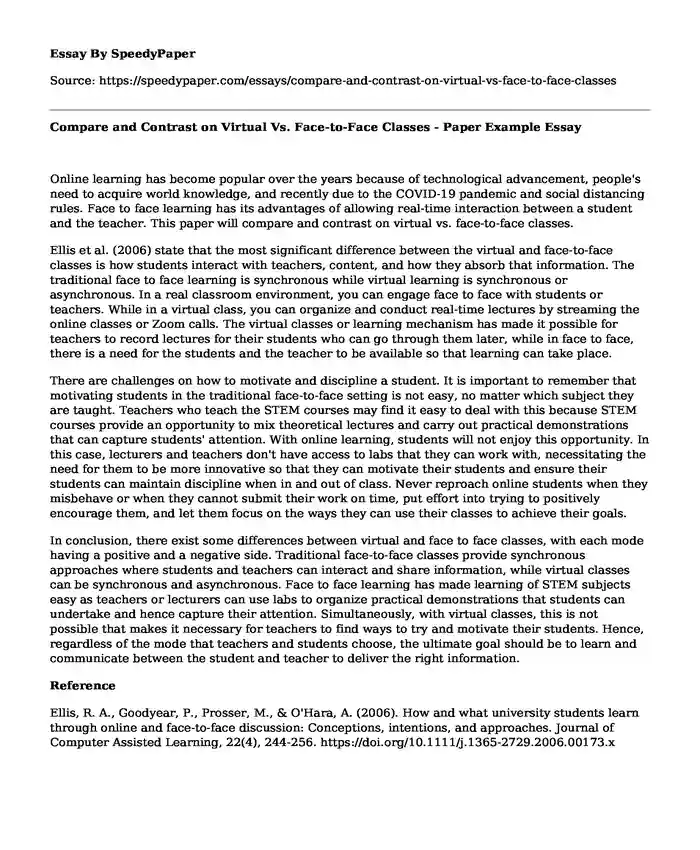
| Type of paper: | Essay |
| Categories: | Education Internet Technology Motivation |
| Pages: | 2 |
| Wordcount: | 514 words |
Online learning has become popular over the years because of technological advancement, people's need to acquire world knowledge, and recently due to the COVID-19 pandemic and social distancing rules. Face to face learning has its advantages of allowing real-time interaction between a student and the teacher. This paper will compare and contrast on virtual vs. face-to-face classes.
Ellis et al. (2006) state that the most significant difference between the virtual and face-to-face classes is how students interact with teachers, content, and how they absorb that information. The traditional face to face learning is synchronous while virtual learning is synchronous or asynchronous. In a real classroom environment, you can engage face to face with students or teachers. While in a virtual class, you can organize and conduct real-time lectures by streaming the online classes or Zoom calls. The virtual classes or learning mechanism has made it possible for teachers to record lectures for their students who can go through them later, while in face to face, there is a need for the students and the teacher to be available so that learning can take place.
There are challenges on how to motivate and discipline a student. It is important to remember that motivating students in the traditional face-to-face setting is not easy, no matter which subject they are taught. Teachers who teach the STEM courses may find it easy to deal with this because STEM courses provide an opportunity to mix theoretical lectures and carry out practical demonstrations that can capture students' attention. With online learning, students will not enjoy this opportunity. In this case, lecturers and teachers don't have access to labs that they can work with, necessitating the need for them to be more innovative so that they can motivate their students and ensure their students can maintain discipline when in and out of class. Never reproach online students when they misbehave or when they cannot submit their work on time, put effort into trying to positively encourage them, and let them focus on the ways they can use their classes to achieve their goals.
In conclusion, there exist some differences between virtual and face to face classes, with each mode having a positive and a negative side. Traditional face-to-face classes provide synchronous approaches where students and teachers can interact and share information, while virtual classes can be synchronous and asynchronous. Face to face learning has made learning of STEM subjects easy as teachers or lecturers can use labs to organize practical demonstrations that students can undertake and hence capture their attention. Simultaneously, with virtual classes, this is not possible that makes it necessary for teachers to find ways to try and motivate their students. Hence, regardless of the mode that teachers and students choose, the ultimate goal should be to learn and communicate between the student and teacher to deliver the right information.
Reference
Ellis, R. A., Goodyear, P., Prosser, M., & O'Hara, A. (2006). How and what university students learn through online and facetoface discussion: Conceptions, intentions, and approaches. Journal of Computer Assisted Learning, 22(4), 244-256. https://doi.org/10.1111/j.1365-2729.2006.00173.x
Cite this page
Compare and Contrast on Virtual Vs. Face-to-Face Classes - Paper Example. (2024, Jan 28). Retrieved from https://speedypaper.net/essays/compare-and-contrast-on-virtual-vs-face-to-face-classes
Request Removal
If you are the original author of this essay and no longer wish to have it published on the SpeedyPaper website, please click below to request its removal:
- Free Essay on Sex Biases in Media
- Three Media Examples of Social Psychology, Free Essay Example
- Free Essay: Social Media and Eating Disorders
- Essay Example with the Response to an Article on the Negative Impacts of the Internet
- Free Essay for Everyone on Streaming and SoundCloud
- Essay Sample on Late Paper Submission: Reasons and Strategies to Avoid
- Paper Example: Understanding the Reasons for Planning
Popular categories




